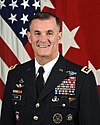
In the US Army, Joseph A. Ryan is the Deputy Chief of Staff for Operations, Plans, and Training (G-3/5/7) serving on Army Staff for operations (G-3), plans (G-5), and training (G-7). Both G-8 and G-3/5/7 sit on the Army Requirements Oversight Council (AROC), chaired by the Chief of Staff of the Army (CSA).
The Army's Force management model begins with a projection of the Future operating environment, in terms of resources: political, military, economic, social, information, infrastructure, physical environment, and the time available to bring the Current army to bear on the situation.
The AROC serves as a discussion forum of these factors.
A DOTMLPF analysis models the factors necessary to change the Current force into a relevant Future force.
The relevant strategy is provided by the Army's leadership to guide Army staff.
The resources are "dictated by Congress".
A JCIDS process identifies the gaps in capability between Current and Future force.
A Force design to meet the materiel gaps is then underway.
An organization with the desired capabilities (manpower, materiel, training) is brought to bear on each gap.
- AR 5-22(pdf) lists the Force modernization proponent for each Army branch, which can be a CoE or Branch proponent leader.
- Army Staff uses a Synchronization meeting before seeking approval —HTAR Force Management 3-2b: "Managing change in any large, complex organization requires the synchronization of many interrelated processes".
A budget request is submitted to Congress.
Approved requests then await resource deliveries which then become available to the combatant commanders.
List of Deputy Chiefs of Staff for Operations, Plans, and Training, G-3/5/7
| This list is incomplete; you can help by adding missing items. (June 2023) |
| No. | Deputy Chief of Staff | Term | |||
|---|---|---|---|---|---|
| Portrait | Name | Took office | Left office | Term length | |
| - |
 | Lieutenant General Daniel P. Bolger (born 1957) | 21 May 2010 | 6 September 2011 | 1 year, 108 days |
| - |
 | Lieutenant General John F. Campbell (born 1957) | 6 September 2011 | 8 March 2013 | 1 year, 183 days |
| - |
 | Lieutenant General James L. Huggins Jr. | 8 March 2013 | May 2015 | ~2 years, 68 days |
| - |
 | Lieutenant General Joseph Anderson (born 1959) | May 2015 | 27 June 2019 | ~4 years, 43 days |
| - |
 | Lieutenant General Charles A. Flynn (born c. 1963) | 27 June 2019 | ~4 June 2021 | ~1 year, 342 days |
| - |
 | Lieutenant General James Rainey (born 1964/1965) | ~4 June 2021 | 3 October 2022 | ~1 year, 121 days |
| - |
 | Lieutenant General Patrick Matlock (born 1965) | 3 October 2022 | 1 November 2024 | 2 years, 29 days |
| - |
 | Lieutenant General Joseph A. Ryan (born c. 1969) | 4 November 2024 | Incumbent | 70 days |
Notes
- ^ Headquarters, Department of the Army (29 Jun 2021) Army Regulation 71–9 Force Management. Warfighting Capabilities Determination °1-6c, p.1) tasks for CG,AFC; °2-24 p.13) CG,AFC is a principal member of AROC, with 43 duties a through qq; °3-1 ch.3 pp20-21) AROC is a forum for requirements decisions (RDF); °4-1 p.24) CG,AFC is responsible for force design; °6-4 p39) figure 6-1 Deliberate staffing and review process; figures for more staffing and review processes follow.
- ^ James Kennedy (2019) Force Management Model - Complete
- ^ United States Army War College and Army Force Management School (2019-2020) How the Army Runs HTAR: A senior leader reference handbook which synthesizes "existing and developing National, Defense, Joint, and Army systems, processes, and procedures currently practiced"